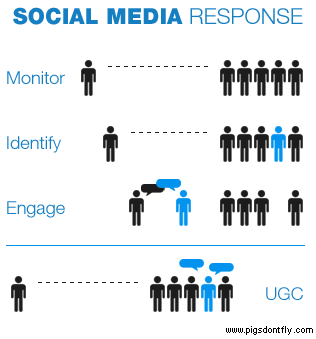14 October 2008 Social Media Strategy: Response
The way I see it, new media is the umbrella that encompasses everything from social media marketing to viral marketing to mobile marketing. Essentially, anything that does not interrupt a consumer with a great focus on consented, engaging and value providing content.
So what is social media? A few days of research, thinking and graphics work have lead me to two key strategies that can be undertaken when it comes to social media marketing. The first, which I’ll be covering here is Response and the second, which I’ll be posting tomorrow, is Broadcast.

Above the line is from marketer’s point of view. Below it, is from the consumer’s.
Monitor
Before jumping into the pool it is important to test the water. Observe your consumer and community in focus from afar. Before posting a comment on someone’s blog, you must first understand what they’re talking about. You should be scoping the scene out to see if you can firstly join the conversation and secondly add to the conversation.
Identify
There are too many blogs, social network profiles, YouTube videos and tweets for you to respond to them all. After monitoring your consumer and community it is important to identify the most influential people within this niche. Using these opinion leaders and those with loyal audiences (not necessarily large), you will be able to more effectively and efficiently target your key customers.
Engage
After monitoring and identify the influential consumers within a community, you can now engage with them. This relationship might be a short or long but either way it should be a case of providing meaningful and relevant value to consumers and their community.
UGC
You have now engaged with the consumer and started a relationship which has been built on the mutual exchange of value. Here the marketer gives up control of the message and the community takes over with the creation of user generated content. It could be something small like establishing and spreading buzz online (or offline) through social networks or something much more involved like writing a blog post or publishing a video on YouTube.
The Body Shop do this extremely well. Not only do they have a blog (see Broadcast), but actively respond to influential bloggers. As a result, I’m creating content about them right now.
This is one of two strategies I have identified that could be used when approaching social media marketing. The other is Broadcast. Please feel free to offer any thoughts or critique.
Edit: I have since updated this model here.

